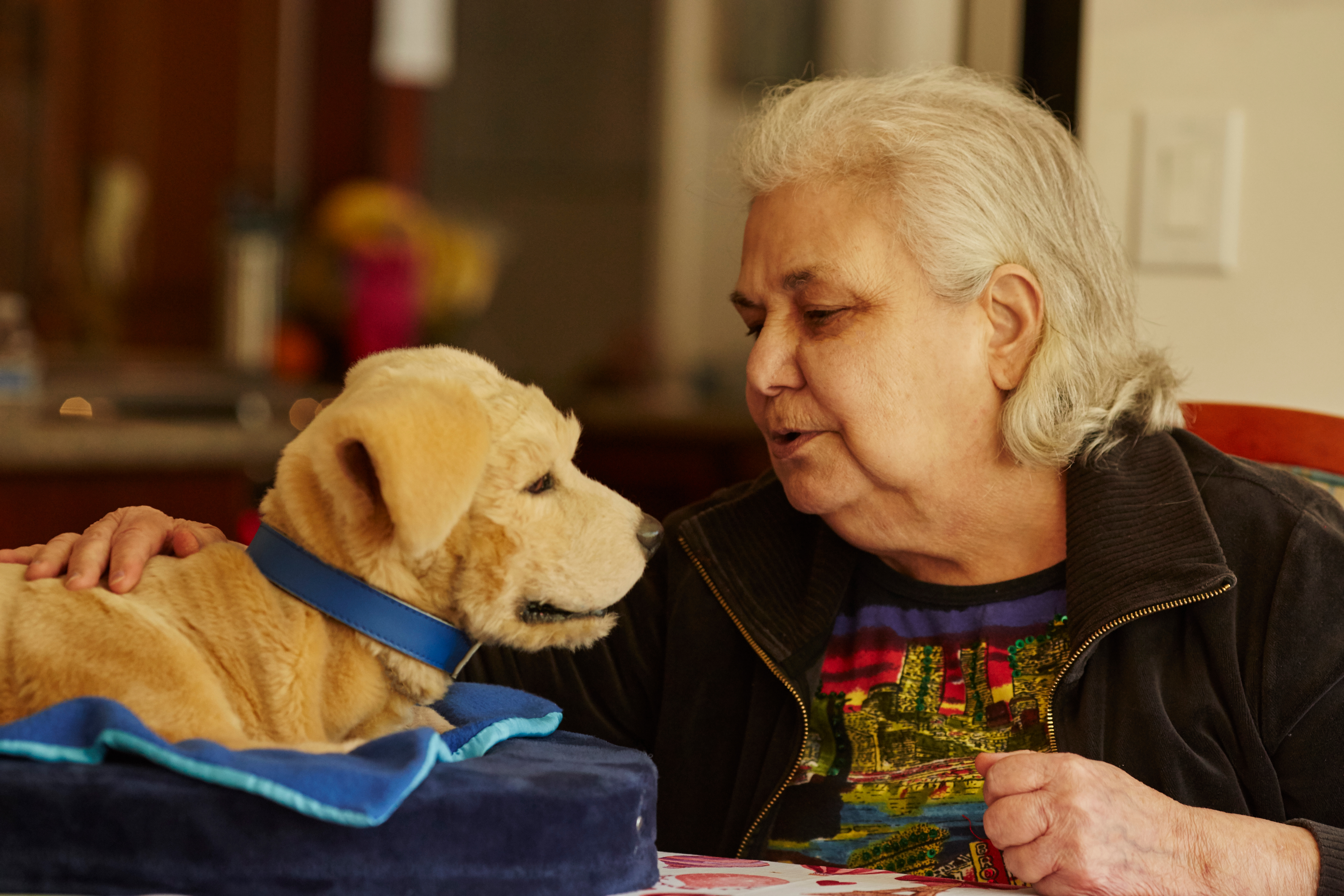How robotic pets can provide comfort for older adults

Robotic pets can offer companionship, comfort, and stimulation for older adults — especially those experiencing loneliness, dementia, or mobility limitations. While not a replacement for human connection, these lifelike pets can help reduce stress, encourage social interaction, and bring moments of joy. They're a simple, low-maintenance way to help improve emotional well-being and quality of life.
We know how much comfort and joy a pet can bring — especially for older adults who may be spending more time at home or feeling isolated. If your parent or loved one has always been an animal lover, you might be wondering how to keep that connection alive without adding stress or responsibility to their daily routine.
That’s where robotic pets come in. Yes — robotic. It may sound like something out of science fiction, but these lifelike companions are designed to look, feel, and even respond like real animals, offering many of the emotional benefits of pet ownership without the upkeep.
Whether your loved one is living with memory challenges or just misses having a furry friend nearby, robotic pets might be a surprising source of comfort.1
This new kind of companionship is more accessible, more manageable, and maybe what your loved one needs.
What are robotic pets?
Let’s dive into the basics of robotic pets:
They’re robots – Robotic pets are man-made. They’re typically battery-powered, they perform pre-programmed movements, and (underneath plush layers of fur or feathers), they’re often made from metal and plastic.
They’re “animal” companions – Robotic pets look and feel like real pets; many models are surprisingly lifelike. For instance, robotic cats blink, meow, purr, and turn their heads to mimic the movements of real cats.
You might be thinking: “My loved one knows what a cat looks like. They won’t be fooled by a robotic version.” Robotic pets are lifelike, but they’re not designed to fool anyone or perfectly resemble their real-life counterparts; they’re designed to provide comfort and companionship, and studies have shown that they’re up to the task (more on these studies later).2
3 benefits of robotic pets for older adults
Robotic pet technology for older adults offers an array of benefits — they provide companionship (and, thus, reduce loneliness), support emotional well-being, and pose limited care demands compared to traditional animal companions.
1. Companionship
The aging journey can be lonely for older adults: As friends and loved ones pass away or growing care demands cut into older adults’ social time, they may become more vulnerable to social isolation.3
Loneliness doesn’t just impact older adults’ social and emotional health. Social isolation can increase the risk of both cardiovascular diseases and cognitive decline in older adults.4,5
It’s no secret that pets provide companionship for humans of any age. They can provide physical affection, comfort, and companionship.
Robotic pets can do all of this and more (without the care demands of traditional pets). Older adults can put robotic animals on their laps, hear their sounds throughout the day, and spend time in their presence.
2. Increased emotional well-being
Spending quality time with family, friends, and pets can brighten anyone’s day and lift their spirits. Feeling connected to others helps improve overall mental health, no matter your age. Studies show that:
Social isolation is a strong predictor of developing anxiety and depression in adults.6 Conversely, spending time with others can protect against these mental health challenges.7
Feeling connected to the world helps provide meaning and purpose, decreases stress, improves feelings of safety, promotes resilience, and increases feelings of hopefulness.
Pets can decrease feelings of isolation and help us feel connected to the world around us. The same is true of robotic pets: By providing companionship, they can increase our emotional well-being.
3. Limited demands
As a caregiver, you have a lot on your plate: coordinating your loved one’s medical care, preparing meals, providing hygiene care, and ensuring their overall quality of life.
There are a lot of amazing pets out there such as dogs, cats, or even a chinchilla. But while introducing a traditional pet into your loved one’s home may benefit their overall well-being, you likely can’t help but think about the increased stress and maintenance demands. Even a low-maintenance pet wouldn’t lighten your load as a caregiver.
Robotic pets don’t just benefit older adults — they help their caregivers, too. Caregivers get the best of both worlds with robotic animals for older adults:
Increased quality of life for their loved one – With a robotic pet, your loved one may feel less lonely and stressed, improving their comfort.
Limited upkeep – While traditional pets need care, robotic animals don’t pose nearly as many demands. Refreshing batteries and maintaining (synthetic) fur or feathers are the only tasks to contend with when it comes to robotic pets.
How robotic pets help older adults with memory loss
While we’ve discussed some of the general benefits of robotic pets for older adults, we haven’t yet zoomed in on a specific population: people with memory loss.
Robotic pets can provide enrichment for anyone navigating their aging journey. But they may be especially impactful for older adults with dementia, Alzheimer’s disease, and other cognitive conditions:
Robotic pets offer real therapeutic benefits: In 2022, the U.S. Department of Veterans Affairs introduced them to support veterans during the pandemic. Staff reported they provided comfort, connection, and relief from memory loss, dementia, and depression.
Robotic pets may ease mental health symptoms: An eight-month University of Plymouth study found that care home residents with robotic pets experienced fewer delusions and depressive episodes than those without them.8
Robotic pets can help reduce loneliness and depression: In a six-week U.S. study of older adults with dementia, participants who interacted with robotic pets reported feeling less lonely and showed significant improvements in depression symptoms.9
Robotic pets may support cognitive health: A 2021 study of adults with dementia found that over half of participants experienced improved attention and language skills, in addition to better mood, after interacting with robotic animals. 10
Simply put, robotic pets have overwhelmingly shown that they can provide a calming influence and increased engagement for older adults with memory challenges.
Types of robotic pets available
As robotic pets are becoming more widely available, there are several options designed to provide comfort and companionship for older adults.
These robotic animals are created to mimic real-life pets with lifelike sounds and movements, offering both emotional support and engagement. Here are some popular types:
Cats – Robotic cats come in various colors and feel like real cats. They feature hypoallergenic "fur," realistic movements, and lifelike sounds such as purring, providing comfort and familiarity to users.
Dogs – Robotic dogs are designed to respond to touch with actions such as wagging their tails, snuggling, and barking. These pets aim to create an interactive and soothing experience.
Birds – These robotic birds can be attached to walkers or wheelchairs, making them particularly helpful for older adults using mobility aids. They chirp in response to light, movement, and touch, offering both companionship and gentle reminders to use assistive devices.
There are a lot of robotic pet brands out there, but here are some of the most popular:
PARO: A therapeutic robotic pet that looks like a baby harp seal and is designed primarily for older adults with dementia.
Joy For All: Robotic therapy pets that mimic real pets such as cats, dogs, and birds to offer companionship and emotional support.
MetaCat: Designed by Elephant Robotics, this robotic pet features voice interaction, touch censors, and realistic sounds.
Tombot: This company creates robotic animals with the goal of revolutionizing emotional support and mental health care for people with dementia, PTSD, anxiety, mild cognitive impairment, and other health challenges. Their hyper-realistic Labrador retriever puppy “Jennie,” looks, feels, and behaves like a real dog.
ElliQ: While it doesn’t resemble an animal, we thought it would be helpful to include it here. This care companion robot uses AI to talk with older adults, offer medication and appointment reminders, suggest activities, and connect you with family members through video calls.
Are robotic pets right for your loved one? 3 factors to consider
While robotic pets can be a comforting and joyful companion for many older adults, they may not be the right fit for everyone. It’s important to talk with your loved one about whether they want one and what kind of pet might feel most comforting. For those living with dementia, a robotic pet can provide companionship and reduce feelings of loneliness, but it’s especially important to consider how your loved one responds to these devices. Some may find comfort in the interaction, while others might feel confused or unsettled.
As you consider this option, keep the following factors in mind.
Ability level
While robotic pets aren’t designed to “fool” older adults (they’re only intended to provide companionship), some people simply may not feel as much affection toward a robotic pet as they would toward a real one, especially if they aren’t facing steep cognitive challenges or are afraid of technology.
Consider your loved one’s abilities. They may be a good fit for a conventional, living pet if:
They don’t experience mobility challenges
They are unlikely to forget to feed and water their pet
They live an active enough lifestyle to provide enrichment for a pet
A caregiver lives nearby (or in their home) to support pet care
Robotic pets are likely the best match for older adults with limited mobility, those with memory challenges, and people living a slower-paced lifestyle.
Distance from caregivers
There’s a reason we mentioned that nearby or live-in caregivers may make it easier for older adults to care for a living pet: Even if your loved one can be depended upon to feed, water, and care for a conventional pet, a lack of nearby support from caregivers may pose challenges.
If you live near your loved one (or they have in-house support), a conventional pet will always have a safety net. If your loved one’s needs change or their pet has a medical emergency, your loved one won’t have to manage pet care on their own.
But in cases where caregivers live remotely, a robotic pet may offer the benefits of a pet without the risk of high-pressure emergencies.
Existing pets
Does your loved one already have pets? Robotic pets simply may not be compatible with their lifestyle:
Pets may see robots as toys: Robotic pets closely resemble plush toys — toys that dogs and cats may damage if they’re left unattended.
Robotic pets may increase confusion: If your loved one has memory challenges but they’re still managing pet care, introducing a robotic pet — a companion that doesn’t require intensive care — may cause confusion.
However, depending on your loved one’s needs and abilities, a robotic pet may be a suitable replacement for a conventional pet. Rehoming a living pet poses ample challenges for caregivers and pet owners alike, but in some circumstances, introducing a robotic pet after the departure of a traditional pet could help provide emotional support.
Welcome to the new age of aging
Technological advancements are changing how we approach aging and companion care. Robotic pets could offer the emotional support, comfort, and enrichment your loved one needs to thrive on their aging journey.
They’re just one example of how we can modernize aging care to support older adults with compassion.
Your first step toward quality care and companionship
Robotic pets can provide comfort, but they’re no substitute for compassionate, person-centered care. Explore the CareScout Quality Care tool to find trusted personalized support.







